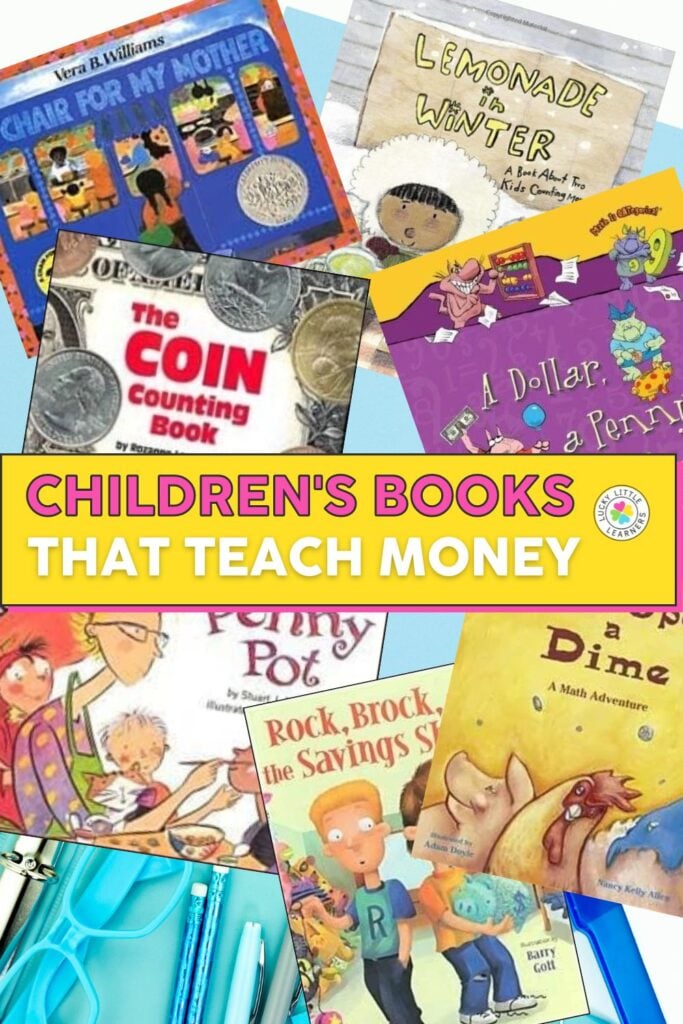
Teaching students about money can be a challenging and multi-faceted endeavor. But it doesn’t have to be!
Using books to help teach your students about money is a fun and engaging way to deepen their understanding of this critical life skill. Financially focused books can help introduce, develop, and extend the crucial aspects of your math money lessons.
Building vocabulary, heightening student interest, and showcasing real-world connections are just a few of the ways that the following books will add enrichment and excitement to your lessons about money! This list includes a combination of books that offer concrete counting and computational skills as well as interesting stories about money. While there are certainly many other great books out there that may not be on this list, hopefully these will help you get started with adding some literature to your lessons on money!
Get Money Resources in our Shop
This post contains affiliate links for Amazon. By purchasing an item on the Amazon site using these links, I will receive a small commission on your purchase. For more information about my Disclosure Policy, please visit this link.
1. Follow the Money!
By Loreen Leedy

Throughout his day, George the quarter visits the Federal Reserve, a local bank, a grocery store, and a child’s piggy bank, among a few other places. This book includes various money-related math challenges that the quarter faces, as well as a section on different types of US money and money vocabulary.
Ages: K-3
Book Activity
Follow up this read-aloud with our Counting Quarters Mini lesson and activities, including digital teaching slides.

2-The Go-Around Dollar
Written by Barbara Adams, Illustrated by Joyce Zairns

Explore the journey of a dollar bill as it changes hands, discovering how money works and fun facts about currency, with colorful pictures and simple explanations, making it perfect for learning about money.
Ages: PreK-3
Book Activity
Talk about what happens when you get more than a dollar by playing “Dollar Bills & Beyond”, a math partner game that has students practice drawing and writing money amounts beyond $1.00.

3-A Chair for My Mother
Written & Illustrated by Vera Williams

Join Rosa, her mother, and grandmother as they save coins to buy a comfortable chair after their home is destroyed, learning valuable lessons about saving money and the importance of family.
Ages: K-2
Book Activity
Created as a Math intervention activity, “Piggy Bank Spin” can also be used as a review game. Students will love playing against a partner, trying to be the first to “break the bank”.

4-The Penny Pot
Written by Stuart Murphy, Illustrated by Lynne Cravath

At the school fair, Jessie faces a dilemma when she wants her face painted but doesn’t have enough money after buying ice cream. However, with the help of a penny pot and patience, she learns valuable lessons about counting money.
Ages: Grades 1-3
Book Activity
Lead your students through a math lesson on the topic of spending vs. saving. This lesson includes teaching slides, a partner game, independent work, a check for understanding and even differentiated options.

5-Rock, Brock, and the Savings Shock
Written by Sheila Blair, Illustrated. by Barry Gott

Rock and Brock learn the importance of saving money when their grandfather offers to match their savings after they do chores for him, showcasing their contrasting spending and saving habits in a humorous tale that encourages readers to think about their own financial choices.
Ages: Grades 3-5
Book Activity
Follow up this read aloud with a collaborative math game from our Lucky to Learn Math curriculum. Play the Spend or Save board game, and practice spending vs. savings just like the characters in the book! You can download the board game here.

6-The Coin Counting Book

This book is all about counting coins, with rhyming text, clear coin images, and a question-answer format that makes it easy to incorporate into math lessons, making it an essential addition to any curriculum for learning about money.
Ages: Grades 1-3
Book Activity
Students can practice their coin counting skills with this math center.
2 Ways to Get This Resource
Join All Access to download everything we've ever made.

Or... Purchase the bundle in our shop.

7-Once Upon A Dime: A Math Adventure

Children will delight in the imaginative tale of a farmer who finds a tree on his land that grows various types of money depending on the animal fertilizer used, offering a unique way to learn about the value of different currencies through a charming premise.
Ages: Grades PreK-2
Book Activity
Take students out for breakfast at “Dime Diner”! Students will love putting together orders and adding up the guest check orders!

Get Money Resources in our Shop
8-Bunny Money
Written & Illustrated by Rosemary Wells

Join Max and Ruby in their quest to buy their grandmother a birthday gift, facing comical challenges and mishaps along the way, before finally finding the perfect presents, with bonus ‘bunny money’ pages for interactive learning.
Age: Grades PreK-2
Book Activity
Students become grocers with this life like grocery store math activity.
Get this exclusively on All Access

Join All Access to download everything we've ever made.
9-The Berenstain Bears’ Trouble With Money

In this story, Brother and Sister Bear learn about the importance of being responsible with money as their parents encourage them to earn their own, providing a fun way for kids to grasp the value of a dollar.
Age: PreK-2
Book Activity
With this writing prompt, students will puzzle over what they could responsibly save up for.

10-Lemonade in Winter: A Book About Two Kids Counting Money

Follow siblings Pauline and John-John as they learn to count money by running a lemonade stand in winter, adding interactive math activities for a fun way to learn.
Age: PreK-2
Book Activity
Students will love planning their own lemonade stands with the math activity (which is part of a daily Lucky to Learn Math lesson!)

11-A Dollar, A Penny, How Much, and How Many?
Written by Brian P. Cleary, Illustrated by Brian Gable

This engaging read uses funny rhymes and silly illustrations to help kids learn about bills and coins, like when buying pizza or pogo-sticks, making it fun to count and combine different types of money.
Ages: K-3
Book Activity
Who doesn’t love a fun game of Bingo?! Take coin counting skills to the next level with “Coin Bonanza Bingo”.

12-You Can’t Buy A Dinosaur With A Dime
Written by Harriet Ziefert, Illustrated by Amanda Haley

Readers follow Pete as he learns about spending and saving money, making decisions about his allowance and discovering tips for smart purchases, all while enjoying a sweet story packed with fun facts about coins, earning money, and charities.
Ages: K-3
Book Activity
Get your class up and out of their seats with a financial literacy themed charades game, which is part of lesson 4.19 in Lucky to Learn Math.

13-Lots and Lots of Coins
Written by Margarette S. Reid, Illustrated by True Kelley

Explore coin history with a boy and his dad, learning about different coins, how they’re made, and the stories behind American money.
Ages: Grades 1-3
Book Activity
Review coin values with these digital teaching slides and activities, part of the emergency sub plans pack.

14-Alexander, Who Used to Be Rich Last Sunday
Written by Judith Viorst, Illustrated by Ray Cruz

Follow Alexander as he learns the importance of saving money, experiencing the thrill of getting a dollar only to see it vanish quickly, teaching readers about saving and practicing subtraction skills along the way.
Ages: K–4
Book Activity
Alexander learns the hard way that money quickly subtracts! Your students can practice subtracting money with the Money Regrouping activity, perfect for small groups! (This activity is part of our Math Intervention Kit.)

15-Pigs Will Be Pigs (Fun with Math and Money)

This fun story turns financial lessons into fun as a pig family hunts for money to eat out after raiding their groceries, engaging readers in counting money and planning meals at the restaurant, perfect for learning about money in an entertaining way.
Ages: K–3
Book Activity
Engage your students with this restaurant themed money counting center, which is part of our Restaurant Classroom Transformation.
2 Ways to Get This Resource
Join All Access to download everything we've ever made.

Or... Purchase the bundle in our shop.

Other Instructional Money Resources
While adding storybooks to your lessons about money is a great way to excite and engage students, there are many other wonderful resources out there! Below I have included links to some excellent products that can truly enrich your lessons on money.
Lucky to Learn Math Unit 4: Money and Personal Finance
First Grade Math Money Notebook
Second Grade Math Money Notebook
Second & Third Grade Math Money QR Task Codes
First, Second, Third Grade Valentine Money Messages
First, Second, Third Christmas Money Messages
First & Second Grade Money Task Cards
If you want to save this post for future reference, feel free to use the image below to pin to your Pinterest board.






You mentioned many books about money for children. I think your information is enough for a child to learn about money. If a kid leaned about money they will be able properly to use money. At present time cryptocurrency is important as well as money. So, I hope you will publish an informative article about it.
Thanks for sharing the valuable article.